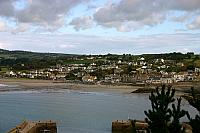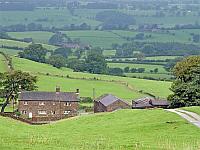Demographic Trends and how they affect Property Investment Potential
Demographics: 'the quantity and characteristics of the people who live in a particular area, especially in relation to their age, how much money they have and what they spend it on'
Baby boomer: 'somebody born during a baby boom, especially the one following the end of World War II'
In this section:
- see how studying UK demographic trends indicates that the UK is a good area for property investing
- see how European demographic trends indicate that you should exercise more caution with properties in European countries such as Italy , Germany , Spain - but with certain exceptions
- see which property types and geographical areas to favour and avoid, based on property demand predictions up to 2050
- see how the aspirations of retiring baby boomers are likely to drive up demand in specific areas and with specific property types.
UK Demographics
 The UK population is projected to increase from some 55 million in 1975 to 68+ million by 2020, mainly through people living longer. Much of this population growth is in the south-east of England .
The UK population is projected to increase from some 55 million in 1975 to 68+ million by 2020, mainly through people living longer. Much of this population growth is in the south-east of England .
Even though we are not reproducing ourselves (average family couples have 1.8 offspring in 2003 instead of the 2.2 need to keep the population replicating), people are living far longer than previously mainly due to improved health care, working conditions and less pollution albeit counter to this trend is that fact that most people get less exercise and are more overweight than 50 years ago. If this trend is reversed, one could expect to see average ages and hence the population grow even higher.
Another important trend is immigration these families tend to have more children when they settle and hence support population growth something which is healthy for supporting higher GDP growth and preventing wage inflationary pressures building (which can in turn lead to higher interest rates). This general demographic situation is well known, fairly deterministic and should help support house prices and demand for property in the longer term. On a small scale, expect the following demographic trends on a UK regional level:
- As baby boomers retire, they will move out of city suburbs to be close to the sea or in leisure areas such as national parks, though most will try and stay close to their families and friends
- Continued strong economic activity in the major service centres will lead to increasing populations and wealth e.g. London , Manchester , Leeds .
- Many rural areas that are not considered good retirement centres may continue to depopulate as farming becomes more difficult (e.g. northern Scotland, mid Wales) though the people that move in may be wealthy ex-city workers wanting a lifestyle change.
- Many retiring baby-boomers will relocate to southern coastal areas in England and Wales where the weather is slightly warmer and scenery un-spoilt.
- City centre living and pied-de-terres will become more popular as amenities (e.g. healthcare) and cultural activities improve for both young and elderly people many commuters will become tired of long daily commutes and have two properties one in the country, one in the city.
- Lifestyle shifting wealthy middle classes moving from London to Cornwall , Devon, Dorset select country areas.
 So there will be a shift of low earning rural people to the cities/suburbs and wealthy city folk to the countryside buying farms and leasing out the land to merged mega-farms. There will be a considerable increase in demand for homes (whether permanent or second homes) with sea/coastal views as the baby boomers retire starting in 2004 (the oldest baby boomer is now 58 years old) and continuing for the next 20 years.
So there will be a shift of low earning rural people to the cities/suburbs and wealthy city folk to the countryside buying farms and leasing out the land to merged mega-farms. There will be a considerable increase in demand for homes (whether permanent or second homes) with sea/coastal views as the baby boomers retire starting in 2004 (the oldest baby boomer is now 58 years old) and continuing for the next 20 years.
European Demographics
 The UK has one of the better demographic trends for house prices compared to other countries, with average families of 1.8 and a net immigration. However, both Spain and Italy have only 1.2 and the population of Italy is forecast to reduce to 40 million in the next 30 years from 55 million in the 1990s. This will certainly not help demand and for this reason we would be very cautious about buying property in Italy . Spain has 1.2 though the net flux of foreigners buying holiday homes is huge hence property in the south coastal area where population is increasing should stay firm, though we wonder whether Madrid will go into the doldrums?
The UK has one of the better demographic trends for house prices compared to other countries, with average families of 1.8 and a net immigration. However, both Spain and Italy have only 1.2 and the population of Italy is forecast to reduce to 40 million in the next 30 years from 55 million in the 1990s. This will certainly not help demand and for this reason we would be very cautious about buying property in Italy . Spain has 1.2 though the net flux of foreigners buying holiday homes is huge hence property in the south coastal area where population is increasing should stay firm, though we wonder whether Madrid will go into the doldrums?
In Germany , the situation is not good the eastern German people in particular have not been having large families and the German population will decline. Both the Netherlands and Scandinavia are more healthy. The theory is that for women in the more traditional, often Catholic, cultures in the south of Europe, child minding is either not available or very expense and difficult to find couples have tried to both work and this has lead to families starting later, being smaller and sometimes not starting at all. It's a complex social phenomenon with many facets, but if you go north and west in Europe , it seems people have larger families may be it's all those cold dark rainy nights in winter! There is also the reluctance or not of government to allow immigration the UK has always been a country with reasonably high immigration levels which has helped support and increase population levels this is not the case in countries like Italy and Austria . For this reason, we see increasing population in the north western areas of Europe, decreases in much of south and eastern Europe and selective increases in holiday destinations where some foreign retired people or holiday homers will settle (e.g. southern Spain, southern France, Greece, Cyprus, a few spots in Italy e.g. Sorrento).
If you put a marker pen along a map all the southern coastal area of the European countries, this correlates quite well with likely areas of future population increase! Head South. These demographics have to be considered when property investing, since of course they tend to drive the demand side of the supply/demand equation, albeit in theory one can still have a declining population and increased demand if everyone decides to have more than one home!
European Demographic Changes up to 2050
Property investment is for most people a long-term financial undertaking so with this in mind, it seems prudent to consider future long-term demographic changes that will affect supply and demand for property in Europe up until 2050. A hundred years ago, the European population was 14% of the world's population. Today this is down to 6%. By 2050 it is forecast by the United Nations to be 4%.
The UN predict the population of the EU will contract by 7.5 million people over the next 45 years this assumes that there will also be a net immigration of 6.8 million hence the indigenous population will decline by some 14 million. In the USA the population will grow by 40% in the same period.
It is not increasing mortality but the low fertility rates in many European countries that will be responsible for this shrinkage. People are getting married later, having fewer kids and many only have one or even no children. If the Italians keep their low fertility rate, and there is not a significant rise in immigration, the UN forecasts the population will drop by 30%.
In Eastern European countries, the population is forecast to drop by 25% in the next 45 years. That said, the prices are likely to rise significantly in most of these countries the next few years as most of them join the EU, but in the longer term we would be very careful since demand will most likely be reduced for all but the nicest retirement property as the population dwindles.
The median age of the Greeks, Italians and Spaniards is projected to exceed 50 by 2050 one in three people will be over 65 years old. Clearly to pay for these retired people, either taxes will have to go up to say 75%, or state pensions and health care expenditure will have to be drastically reduced.
In NW Europe, the situation is more healthy - in the UK , Scandinavia, Holland , Belgium and to a lesser extent France . But in eastern and southern European countries, there will be a significant decline in the population.Predictions for Property demand up to 2050
 Based on these projections of an aging population, we have prepared a few types of property that will be in demand, and those that will not be in demand as this demographic shift takes place from now until 2050:
Based on these projections of an aging population, we have prepared a few types of property that will be in demand, and those that will not be in demand as this demographic shift takes place from now until 2050:
Property In Demand
- Secure luxury apartments in nice neighbourhoods close to city centres in UK (mainly in the south e.g. London , Southampton, Portsmouth , Bristol , Bath ), Scandinavia and France
- Medium sized bungalows and holiday homes on the south coast of NW European countries UK , Norway , Sweden , France suitable for retirement
- Luxury apartments, villas and holiday homes in tourist areas on the southern coast of Spain, Greek islands, Italy western coast, south of France, Balkan coastal area, Cyprus, east coast of Bulgaria
- Rural retreats in France bought by wealthy retiring UK and Dutch citizens
- Quality medium sized home in the England and south Wales in secure areas in market towns, historic university towns and villages the further south the more popular
 Seaside property with sea views along south coast of England e.g. Cornwall , Devon , Sussex .
Seaside property with sea views along south coast of England e.g. Cornwall , Devon , Sussex .
Property Not in demand
- Large suburban houses in average areas in cities in Spain , Austria , Switzerland , Italy , Portugal , Greece , eastern European countries and Germany
- Village and rural homes in eastern European countries that are not close to airports and amenities and cannot be classified as either holiday, second or retirement homes.
- Run of the mill family homes with many bedrooms in areas not close to good amenities, health care, city centre culture and tourist attractions
Property in expensive country areas in Italy and Germany and city suburban property particularly inland in the colder and more industrial north of the countries (e.g. Milan, Turin, Hamburg, Essen, Saxony) will likely see stagnating house prices since economic growth will be anaemic as the baby boomers retire, populations decrease, wage earnings growth is low and taxes increase to pay for the retired.
In European countries where wages and the standard of living is still rising, one can expect to see prices moving up towards the Italian level examples of such countries are Spain, Greece, Slovenia. However, after they have caught up, unless the property is a good home suitable for a local or international retiring baby-boomer, we would not advise investing in this.
“Baby Boomers” Demographics and Desires
 A key consideration in future property investments is how will the baby boomers affect market prices and demand, and which segments will this be in? The baby boomers are those born between mid 1946 (end the World War II) and 1964. This was an unprecedented baby boom period in the UK , Europe and the USA . Immediately after the war, a surge in babies resulted from servicemen arriving home late 1945 and this continued at rather high levels until the early 1960s (peaking in the late 1950s). It led to the house building boom of the late 1950s and 1960s when 3-4 bedroomed houses were built in suburban areas to house rapidly expanding families.
A key consideration in future property investments is how will the baby boomers affect market prices and demand, and which segments will this be in? The baby boomers are those born between mid 1946 (end the World War II) and 1964. This was an unprecedented baby boom period in the UK , Europe and the USA . Immediately after the war, a surge in babies resulted from servicemen arriving home late 1945 and this continued at rather high levels until the early 1960s (peaking in the late 1950s). It led to the house building boom of the late 1950s and 1960s when 3-4 bedroomed houses were built in suburban areas to house rapidly expanding families.
These baby boomers are just starting to retire now the first wave are now 58 years old in 2004 most retire between 60 and 65 years old. In the next twenty years there will be a huge opportunity to service these baby boomers they are the ones who have benefited most from the boom economic years and have already driven house prices to record highs. They are currently in their peak money generating years (40s and early 50s). So what next? My prediction is that these baby boomers will want the following:
Sun, sea, sand, surf, south, sailing
 These new baby boomers will not want to sit out their retirement most will be active, sporty, fit, desire the café culture, want to travel extensively, and be independent. They will not desire boring warden assisted retirement complexes in the middle of nowhere
These new baby boomers will not want to sit out their retirement most will be active, sporty, fit, desire the café culture, want to travel extensively, and be independent. They will not desire boring warden assisted retirement complexes in the middle of nowhere  what they will desire is fun, the sea, a community and proximity to family, friends and culture. They will avoid high crime areas, want to be close to airports and avoid traffic jams. They may also desire to return to where they or their family grew-up if they had fond memories, or move to where they enjoyed family holidays. In summary, they are likely to either:
what they will desire is fun, the sea, a community and proximity to family, friends and culture. They will avoid high crime areas, want to be close to airports and avoid traffic jams. They may also desire to return to where they or their family grew-up if they had fond memories, or move to where they enjoyed family holidays. In summary, they are likely to either:
- Stay put if they already live in a nice home
- Have a second home in a holiday resort probably at the coast (sun, sea, sand, sailing)
- Have a secure apartment in a town or city centre with culture (e.g. Paris , London , Barcelona )
We believe the ideal investment to service these needs is a medium-high end two double bedroomed apartment with balcony overlooking the sea or marina (example locations would be the south coast of England or Spain etc). There will be more and more baby boomers chasing less and less property and it's just beginning. The suburban semi-detached and detached houses so called commuter properties will probably become less fashionable. Large houses in the countryside with land will probably increase their value, although these properties may become difficult for the elderly people to maintain and service in later years.
 We believe the biggest increase could be in coastal areas where property prices have not risen too much already and are being gentrified. Some of these are the old Victorian seaside resorts. Now Brighton has already tripled in price, because of its proximity to London , culture, historic houses and seaside / marina. But there are many other such old resorts that are less than half the price. These include Hastings , Folkestone, Margate/Broadstairs, Bexhill and Eastbourne .
We believe the biggest increase could be in coastal areas where property prices have not risen too much already and are being gentrified. Some of these are the old Victorian seaside resorts. Now Brighton has already tripled in price, because of its proximity to London , culture, historic houses and seaside / marina. But there are many other such old resorts that are less than half the price. These include Hastings , Folkestone, Margate/Broadstairs, Bexhill and Eastbourne .
Any improvement in infra-structure in these towns will improve things further examples are the new arts University in Hastings , new high speed train link from Folkestone to London St Pancras. Other places to benefit should be Chatham/Rochester, Whitstable and Gravesend . As more baby boomers settle in these coastal towns, the café culture should improve, crime levels reduce and gentrification kick-in.
We see particular capital growth in these areas in the next 10-15 years, as more baby boomers decide to settle outside urban conurbations to the seaside. The sea, sand, sun, surfing, sailing, walking, cycling, café culture and activities / amenities will increase demand in these areas. That is not to say that the main city centres will not do well. Baby boomers may also choose to have a pied-de-terre for tourism, leisure, maintaining business and investment contacts, visiting family and friends hot areas are likely to be Bow, Hackney, Bethnal Green, Stratford , Canning Town and Silvertown in London along with established prime areas in West London such as Kensingon, Chelsea , Bayswater and Battersea/Clapham and Fulham. These properties are likely to be secure semi-luxury apartments in good central locations.

